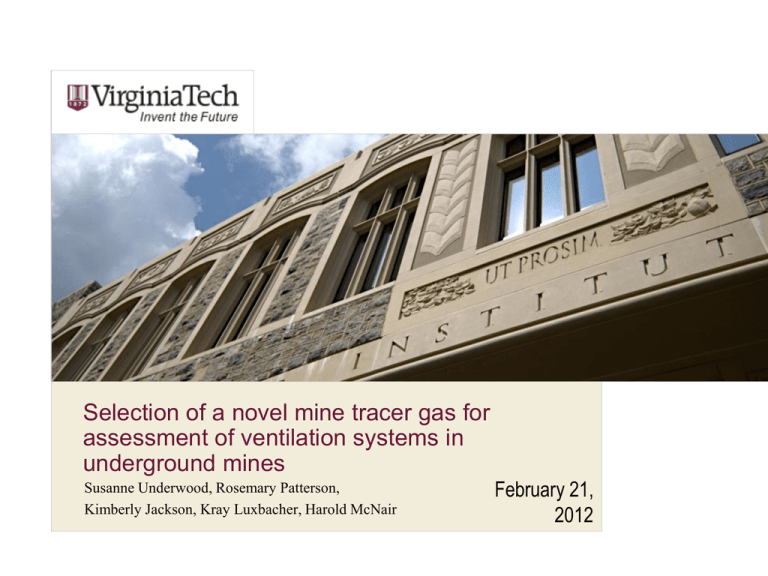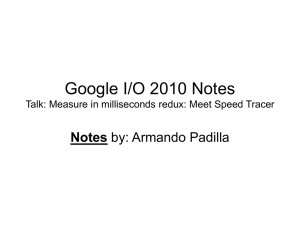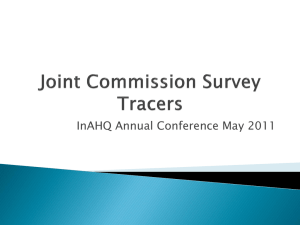PPT - SME
advertisement

Selection of a novel mine tracer gas for assessment of ventilation systems in underground mines Susanne Underwood, Rosemary Patterson, Kimberly Jackson, Kray Luxbacher, Harold McNair February 21, 2012 Acknowledgements This publication was developed under Contract No. 200-2009-31933, awarded by the National Institute for Occupational Safety and Health (NIOSH). The findings and conclusions in this report are those of the authors and do not reflect the official policies of the Department of Health and Human Services; nor does the mention of trade names, commercial practices, or organizations imply endorsement by the U.S. Government. Outline Background • Ventilation surveys using trace analysis • Tracer characteristics • Previous uses of considered tracer elements Application • Results of tracer analysis • Selection of a tracer element • Development of analysis method Summary • Future work • Conclusions Background Project Objective • To select a safe novel tracer • Novel tracer must have similar sensitivity to current tracers • Develop one analysis method to allow for concurrent deployment of tracers Background Tracer Technique • Directly measures air quantity • When traditional point measurement of velocity cannot be used including – Where cross-sectional area cannot be easily measured – Locations deemed unsafe due to emergency – Places with very low or irregular flow Background How does the tracer technique work? • Tracer is directly released into atmosphere • Gas chromatography analysis • Two methods – Continuous tracer release – Pulse tracer release • Limited applications due to time Background How will a novel tracer help? • Increase ventilation survey versatility • Simultaneous analysis of airways/leakages • Reduces the time limitations of traditional tracer analysis Background Tracer Requirements • Easily detected and analyzed • Absent from mine air • Nonreactive, nontoxic, noncorrosive, nor explosive • Readily attainable • Easily transported • Highly sensitive Background Tracers Considered • Industry standard is Sulfur Hexafluoride (SF6) • Freons – Carbon Tetrafluoride (CF4) – Octofluoropropane (C3F8) • Perfluorocarbon tracers Background Previous Tracer Applications • Freon testing in mines • Perfluorocarbon Tracers – Urban environments – European Tracer Experiment – Oil and gas reservoirs – Home ventilation systems – No evidence that PFTs have been used in mines Background PMCH Characteristics • • • • • • C7F14 Volatile liquid Boiling point of 67⁰C Biologically inert Molecular weight of 350 g/mol Very low ambient backgrounds Application Experimental Design • Shimadzu 2014 Gas Chromatograph • Electron Capture Detector • Columns tested for Freons – – – – SBP-1 Sulfur ZB-624 TG Bond Q+ TG Bond Q • PMCH tested using HP-AL/S column Application Goals • Achieve separation between peaks • Attain Gaussian shaped peaks • Apply an acceptable method Column SBP-1 Sulfur Column ZB-624 Column TG Bond Q+ Column TG Bond Q Column HP-AL/S Column Average Retention Time (min) Column Temperature (⁰C) O2 SF6 CF4 C3 F8 PMCH 40 1.1 1.22 1.1 1.2 --- 20 1.08 1.19 1.1 1.24 --- 40 2.14 2.22 --- 2.23 --- 20 2.14 2.22 --- 2.27 --- 0 2.14 2.24 --- 2.17 --- 40 1.94 2.22 2.12 3.49 --- 20 1.96 5.22 --- 5.22 --- 0 1.96 9.65 --- 9.84 --- 60 2.3 3.1 --- 3,09 --- 50 2.33 3.42 --- 3.41 --- 40 2.24 3.88 --- 3.88 --- 20 2.27 5.74 --- 5.7 --- 0 2.27 10.6 --- --- --- 70 2.09 2.43 --- --- 9.61 67 2.07 2.44 --- --- 9.69 65 2.08 2.48 --- --- 9.74 Column SBP-1 Sulfur Column ZB-624 Column TG Bond Q+ Column TG Bond Q Column HP-AL/S Column Average Peak Area of Gases Column Temperature (⁰C) SF6 CF4 C3 F8 PMCH 40 8.91x107 1.43x104 1.44x104 20 7.69x107 1.56x104 1.30x104 ----- 40 5.93x107 2.07x103 1.02x104 20 6.12x107 --- 8.63x103 0 6.57x107 --- 2.20x105 40 5.93x107 2.79x103 1.15x105 20 1.091x108 --- 6.15x104 0 1.100x106 --- 4.13x104 60 2.56x107 --- 3.34x105 50 2.60x107 --- 4.18x105 40 7.26x106 --- 3.88x103 20 4.50x106 --- 0 3.70x106 --- 1.960x103 --- ----------- 70 3.44x107 --- --- 4.95x107 67 4.24x107 --- --- 6.34x107 65 6.18x107 --- --- 7.97x107 ------------- Application Chromatogram Results µV(x10,000) min Application Chromatogram Results µV(x100,000) min Application Chromatogram Results µV(x10,000,000) Column Name HP-AL/S Column Type Capillary Column Length 30 m Inner Diameter 0.250 mm Film Thickness 5 µm Split Injector Temperature 150⁰C Split Ratio 50:1 Pressure 16.2 psi Carrier Gas He Total Flow 60.8 mL/min Make Up Gas N2 Column Flow 1.15 mL/min Linear Velocity 30 cm/s Septum Purge Flow 2.0 mL/min Detector Temperature 200⁰C Initial Column Temperature 67⁰C hold 2.75 min Ramp 120⁰C/min Final Column Temperature 180⁰C hold 12.30 min Total Program Time 15.99 min min Summary Future Work • PMCH vulnerabilities to sample loss • Methods of release – Permeation tubes – Fluoroelastomer plug source – Gas Cylinders Summary Conclusions • Unsuccessful separation when using Freon gases • PMCH is a favorable tracer selection – Successful separation – Encouraging previous applications • A simple GC method has been developed Summary Thank you Questions?







